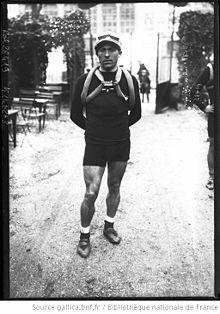|
1913 Giro d'Italia
The 1913 Giro d'Italia was the fifth edition of the Giro d'Italia, a Grand Tour organized and sponsored by the newspaper La Gazzetta dello Sport. The race began on 6 May in Milan with a stage that stretched 341 km (212 mi) to Genoa, finishing back in Milan on 22 May after a 321.1 km (200 mi) stage and a total distance covered of 2,932 km (1,822 mi). The race was won by the Italian rider Carlo Oriani of the Maino team.[1][2] Second and third respectively were the Italian riders Eberardo Pavesi and Giuseppe Azzini.[3] It was the last Giro with a final classification in points and the first one in which the final winner of the race did not win a single stage. The Giro saw the debut of the twenty-year-old Costante Girardengo, who won the 6th stage. The 1913 Giro was the last concluded by Luigi Ganna, winner of the first edition. Changes from the 1912 Giro d'ItaliaOutside the yearly changes in the route, race length, and number of stages, the biggest change to how the general classification was to be calculated. The race organizers decided to change back to the way the general classification had been calculated in the earlier editions, by the individual and the awarding of points based on how high the rider placed in each stage rather than doing a team points based system like the previous edition. ParticipantsOf the 99 riders that began the Giro d'Italia on 6 May,[4] 35 of them made it to the finish in Milan on 22 May.[5] Riders were allowed to ride on their own or as a member of a team. There were eight teams that competed in the race: Ganna-Dunlop, Gerbi-Dunlop, Globo-Dunlop, Legnano-Dunlop, Maino-Pirelli, Otav-Pirelli, Peugeot Italy-Tedeschi, and Stucchi-Dunlop.[5] The peloton was composed completely of Italians.[5] The field featured three former Giro d'Italia champions in the 1909 winner Luigi Ganna, three-time winner and returning champion Carlo Galetti, and returning champion Eberardo Pavesi.[5] Other notable Italian riders that started the race included Giovanni Rossignoli, Alfredo Sivocci, Carlo Oriani, and Giuseppe Azzini.[5] Among the riders was Edoardo Bardelli, who had recently turned seventeen. Bardelli is the youngest rider to have started the Giro d'Italia.[6] Race detailsThe first stage ended with a sprint between Santhia and Albini; Santhia won and became the first leader.[7] In the second stage, Pavesi suffered from a flat tire, but he was able to get back to the peloton, and then get away from the other riders, finishing alone. Albini became the new leader.[8] In the third stage, a large group stayed together until the last checkpoint in Narni. There, the soigneurs of the Legnano cycling team (with Borgarello, Albini, Pavesi, Albini and Canepari) had not arrived yet, so they could not get their foods and drinks. Santhia and Azzini saw an opportunity and escaped; when Azzini had a flat tire, Santhia continued alone, and won the stage, becoming the leader of the general classification.[9] Stage four was won by Giuseppe Azzini, in his first year as a professional cyclist. Santhia finished in third place, keeping the overall lead.[10] Azzini also won the fifth stage. An important event in that stage was a late flat tire for Santhia. Because of his low position in the stage, he lost the overall lead to Pavesi.[11] In the sixth stage, Santhia abandoned because he was ill. A young Costante Girardengo won this stage, the first of 30 stage victories in the Giro.[12] The seventh stage was won by Canepari, in a long solo escape.[13] Pavesi finished the stage in twelfth place, and lost the lead to Azzini, who was only one point ahead of Oriani.[14] The eighth stage ended in a sprint. Only the first seven riders could be ranked by the jury, the rest was put ex aequo on the eighth place. Bordin won the sprint, with Oriani in second place; this was enough for Oriani to become the new leader in the general classification.[15] The only rider who could take the overall victory away from Oriani was Azzini. Midway in the stage, Oriani had a flat tire. He changed a wheel with his team mate Agostoni, and had to chase the main group (including Azzini). Azzini rode hard to stay away from Oriani, but Oriano was able to get back to Azzini's group, and when he saw that Azzini was tired, he immediately rode away. Some riders followed him, but Azzini was not able to follow. Oriani's escape group stayed away until the finish, and Oriani thus won the Giro.[16] Final standingsStage results
General classification There were 35 cyclists who had completed all nine stages. For these cyclists, the points they received from each of their stage placing's were added up for the general classification. The cyclist with the least accumulated points was the winner.
Isolati rider classificationThere was a classification for only the isolati riders that was called the "Premio Momo," it was calculated in the same manner as the general classification.[20]
Team classificationTo be eligible for the team classification, known in Italian as the Premio dell'Industria, the team must have three riders complete the course.> For each team that had at least the necessary three riders complete the race, the three riders with the lowest point totals from the team would be added together to give each team its score.[20] The team with the lowest total of points was the winner of the classification.[20]
AftermathUpon winning the race, Carlo Oriani enlisted in the Corps of the Bersaglieri, the Italian infantry, and got commissioned into World War I.[22] Oriani died in a military hospital in Casserta.[22] The 1913 Giro was considered successful; there were few irregularities, and all but two stages had successful escapes.[23] ReferencesFootnotes
Citations
Bibliography
--External links==
|
|||||||||||||||||||||||||||||||||||||||||||||||||||||||||||||||||||||||||||||||||||||||||||||||||||||||||||||||||||||||||||||||||||||||||||||||||||||||||||||||||||||||||||||||||||||||||||||||||||||||||||||||||||||||||||||||||||||||||||||||||||||||||||||||||||||||||||||||||||||||||||||||||||||||||||||||
